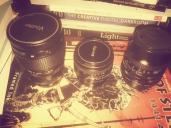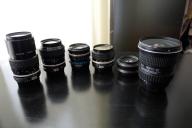
-
@BurnetRhoades So cinematic is about keeping technical stuff (e.g. shutter speed) in the proper range, but ultimately for the sake of taking "stills" that have the motion and storytelling feeling. Could it help to learn if I just go out and try to shoot stills that have a cinematic vibe?
I read your comment and then I started watching Cairo Time (it was on my watching list), and it makes sense what you say (Cairo Time has great "stills"), but in the end it means you need talent and/or hard work to be able to take stills like that. "Beauty is in the eye of the beholder" stands true once again, and then the beholder just needs to put the camera between himself and the beauty.
And it's easy to try to evade hard work by thinking stuff like "oh but those are anamorphic, now I need an anamorphic adapter" and so you fall back in the "I need that gear because otherwise I can't get cinematic" roller-coaster.
-
@kankala Don't get too focused on the "stills" aspect of what I was talking about. I was simply using that as an illustration that so many of the things that get discussed here and elsewhere about what it takes to get "cinematic" images out of their camera aren't actually the most relevant factors. If they become irrelevant looking at a pause of a motion picture, anywhere in the course of the film, then odds are they're not "the answer", they're at best a smaller piece of the puzzle, perhaps.
-
Here's a set of my vintage lenses. Vivitar 55mm 2.8 macro, Hexanon 40mm 1.8, and Vivitar 28mm 2.0. All usable at 2.8.
I know CINE lenses... but WTH is "cinamatic" lenses? Are there some magical lenses that can turn so-so work to awesome cinamatic work? ORLY? Haha

 image.jpg640 x 480 - 121K
image.jpg640 x 480 - 121K -
I don't want to get into the whole "crop factor" debate here, but looking at few Red Epic operators, pretty much all of them have these fast (under f 1.5) lenses in their arsenal;
24 / 35 / 50 / 85
Considering the AOV of S35 vs GH2 16:9 mode, would these be close enough?
14 / 24 / 35/ 50
Looking at the Nikkor lens list, I would say that for "cinematic" feel one should try to get the good framing / color grading with Lumix glass for the wide end, and use 35 1.4 and 50 1.2 or 1.4 for the tele end. I don't see any fast Nikkor primes under 35mm.
Correctamente? :D
-
I used to own the Angenieux 35-70mm not too long ago. It is a retrofocus lens, about 1 stop brighter than the average zoom, but boasts quite a bit of purple fringing. I sold it cosof its rotating front, and variable f stop. i also had the Angenieux 45-90mm f2.8. A great lens in terms of sharpness, but its colour rendition is warmer than Leica's usual palette, and so makes it an awkward lens to match. I sold it as well, even though it is a rarity.
Now i only use Contax lenses. Amazing visceral quality
-
@Riker the speed of the lenses gives you room to stop-down to a better place. Those 1.4, 1.2, etc. lenses are going to look much better at 2.8 than they do fully-wide. You can get a 24mm and 28mm Nikkor that performs decent at this stop but, the Lumix and Noktors (budget allowing) preclude full-coverage, which may not be a consideration for everyone but we shouldn't forget the real investment with any camera package is the lenses.
Stops below 2 are generally going to fall into the completely unlit, at night, just hoping to get something and shouldn't, in most circumstances, be a target stop to live in. It's nice knowing your lens could go there if necessary but it doesn't represent a solution for getting "cinematic" or how actual movies are generally shot.
-
@BurnetRhoades +1 except one thing. I'm not sure that the real investment is the lenses anymore. Affordable CINE like lenses just began appearing. Those are the first generation. Of course they will be improved over the time at affordable prices, and the resale values of the current lenses will be dropped over the time.
-
Much of the "cine like" aspects you're paying for are luxuries that don't necessarily have to do with the optics. Those IMAX action sequences for The Dark Knight Rises were mostly shot through medium-format stills lenses adapted to the 65mm camera system, sorta like what we're doing with 16mm and 35mm lenses and these cameras.
Personally, though it does negatively impact my options for anamorphic shooting, I have a lot of pause considering any lens these days that would have to sit unused in my bag if I wanted to Speed Boost. Just saying.
Oh, I'm kinda broke too, so that trumps any other consideration regarding lens purchase ;)
-
+1. I'm selling unused gears. February is the best month to sell. I'm keeping EF, F, and R mount adapters though. I noticed that more people are not using their lenses. Befriend with more people. Borrow their lenses for free :) well.. almost free.
-
Befriend with more people. Borrow their lenses for free :) well.. almost free.
Hah! That's how I got a sack full of L-Series glass to shoot Sick Boy. My buddy has a serious investment in lenses for his 1D. I think that 85mm f/1.2L was worth more than all my lenses as a whole.
-
Someone should make a video about "borrowing lenses". Haha.
-
"Really, I won't scratch it, promise."
LOL, I did keep that promise though. For all exteriors where we had the camera (also a loaner from one of the exec producers) strapped to or inside a moving vehicle I stuck to the 7D's kit lens.
-
Shhhh I had to remove UV filter, too. I hate stupid ugly flares from it. But that means their beloved lenses could get damaged... but I try my best. "Really, I won't scratch it, promise." :)
-
"the speed of the lenses gives you room to stop-down to a better place. Those 1.4, 1.2, etc. lenses are going to look much better at 2.8 than they do fully-wide."
Not always true. Some Contax lenses that start at 2.8 look better than their 1.4 counterparts at the same aperture, and the 50mm 1.7 looks better than the 1.4 at the same stop.
-
That's true, you can't count on consistency across even a single manufacturer. I've seen tests of Nikkors comparing various zooms and other primes in the 24-28mm range and the disparity in quality, in the corners especially, was all over the place. Generally speaking though, especially these older stills lenses, they get markedly better the closer you get to medium f/4+ stops where the photographers of their era would be more likely to be operating.
I'd figure on the faster stops for these lenses were mostly there for journalists who wouldn't be working in a studio environment with predictable, controllable light. Soft corners would be the least of their worries.
-
After downsizing lens collection, here's my manual focus lens set.
- SLR Magic 12mm 1.6
- SLR Magic 25mm 0.95
- Vivitar Komine 28mm 2.0 Close Focus FD
- Konica Hexanon 40mm 1.8 AR
- Canon FD 50mm 1.4
- Vivitar Komine 55mm 2.8 Macro AR
Total around $1500 including adapters.
-
Really liking the FD lenses. Need to get more at some point. - 85mm f1.2L - 50mm f1.8 - Tamron 80-210 f3.8 adapted to FD - Helioss 44M ( no adapter yet)
Need to get wider lenses!
-
Just curious @stonebat, how different are the SLR 25mm and Vivitar 28mm at f2.8 regarding "cinematic" (what the f*ck is this anyway, i mean "filmmaking wise") quality?
-
@Flaaandeeers LoL. I have no idea how lenses are related to "cinematic". Ask to the guy who created this thread. About the 25mm and the 28mm, both are quite nice. I like'em both. Just my greed to hold'em both.
-
These are the lenses that I use the most.
- Tokina 11-16 2.8
- Pany 20 1.7
- Nikkor 28 2.8 Ais
- Nikkor 50 1.8 Ais
- Nikkor 105 2.5 Ai
- Nikkor 135 2.8 Ai
Bit heavy on the long end, but I found that I use long lenses a lot. These nikkors are very nice and sharp, sturdy, they cam be easily declicked and match nicely. Also, all of them having 52mm thread is very convenient.
What keeps them from being great cinematic lenses is a bit of breathing, but that's the case with most photographic lenses more or less. When used with anamorphic it is even more pronounced.
There is a nice pic of them all together hanging out.

 lenses.jpg2376 x 1584 - 692K
lenses.jpg2376 x 1584 - 692K -
What keeps them from being great cinematic lenses is a bit of breathing, but that's the case with most photographic lenses more or less.
They still create a nice cinematic image though. I really like the look of Nikkors. That's all that matters to me in the end... :)
-
What keeps them from being great cinematic lenses is a bit of breathing, but that's the case with most photographic lenses more or less. When used with anamorphic it is even more pronounced.
Anamorphic lenses breath. This is listed in the plus column, a defining look even, on Panavision's website.
-
...and lens breathing might actually be the new king of "things audiences don't give a shit about"... right after the current champion: Rolling Shutter.
-
I like nikkors and don't mind the breathing, only trying to be objective. If you compare them to any real cinema prime they do breathe and their front element extrudes while focusing, which is another pita for matteboxes and anything screwed in and fixed infront.
Maybe that comparison is not fair, since these are pristine photo lenses, but still, we are talking about using photo lenses for cinema, and I'm just pointing out things that should be taken into consideration.
...and lens breathing might actually be the new king of "things audiences don't give a shit about"... right after the current champion: Rolling Shutter.
hahahah, lol. THis little breathing as these nikkors have really should not bother anyone.
-
"Every talk ends up either about being cinematic, or F stop, or equivalent lens focal length, or sex."
I've looked everywhere and can't find a damned thing about sex - I must have missed a topic... ;-)
Howdy, Stranger!
It looks like you're new here. If you want to get involved, click one of these buttons!
Categories
- Topics List23,992
- Blog5,725
- General and News1,354
- Hacks and Patches1,153
- ↳ Top Settings33
- ↳ Beginners256
- ↳ Archives402
- ↳ Hacks News and Development56
- Cameras2,367
- ↳ Panasonic995
- ↳ Canon118
- ↳ Sony156
- ↳ Nikon96
- ↳ Pentax and Samsung70
- ↳ Olympus and Fujifilm101
- ↳ Compacts and Camcorders300
- ↳ Smartphones for video97
- ↳ Pro Video Cameras191
- ↳ BlackMagic and other raw cameras116
- Skill1,960
- ↳ Business and distribution66
- ↳ Preparation, scripts and legal38
- ↳ Art149
- ↳ Import, Convert, Exporting291
- ↳ Editors191
- ↳ Effects and stunts115
- ↳ Color grading197
- ↳ Sound and Music280
- ↳ Lighting96
- ↳ Software and storage tips266
- Gear5,420
- ↳ Filters, Adapters, Matte boxes344
- ↳ Lenses1,582
- ↳ Follow focus and gears93
- ↳ Sound499
- ↳ Lighting gear314
- ↳ Camera movement230
- ↳ Gimbals and copters302
- ↳ Rigs and related stuff273
- ↳ Power solutions83
- ↳ Monitors and viewfinders340
- ↳ Tripods and fluid heads139
- ↳ Storage286
- ↳ Computers and studio gear560
- ↳ VR and 3D248
- Showcase1,859
- Marketplace2,834
- Offtopic1,320











